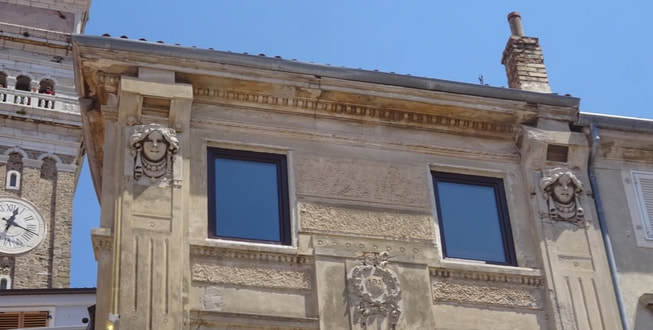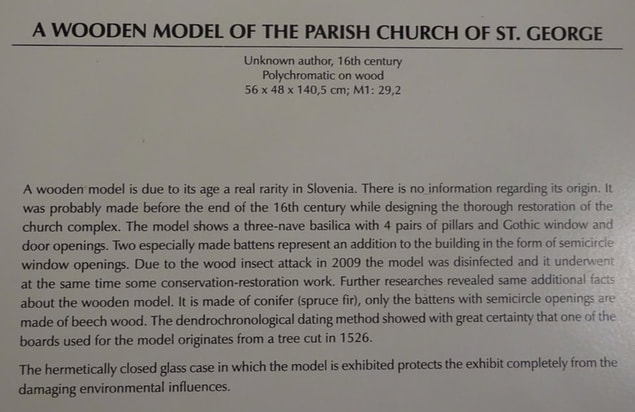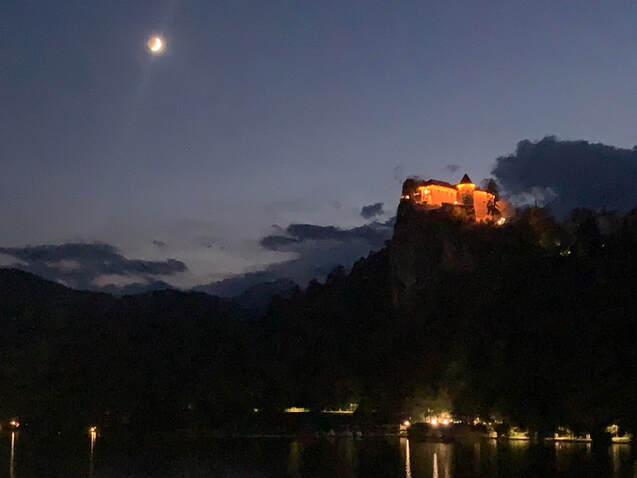Nearing the border crossing from Croatia into Slovenia. I don't remember any airplanes landing, but they would have been just over our car in this landing direction.
Our first tour today, the city of Piran, Slovenia. We park in a modern parking deck, and board the bus indicated below which drops us off right at the central square.
The shiny looking square used to be the inner marina until 1894.
"Giuseppe Tartini (April 8, 1692 – February 26, 1770) was an Italian composer and violinist of the Baroque era born in the Piran. Tartini was a prolific composer, with over a hundred of pieces for the violin. He is most famously remembered for his Violin Sonata in G Minor."
Town Hall
Now at St. George's Parish Church in Piran, built in the 14th century - its museum contains some interesting items on display.
We weren't able to go up to the town walls for a good photo of the church, but here's one that was posted to Wikipedia by photographer: Richard Huber, August 2009; here with permission, unchanged except for "Jpeg'd".
https://commons.wikimedia.org/wiki/File:Piran,_Kirche_St._Georg_mit_Baptisterium.JPG
Rick Steves' says "why such a large church for a smallish town, it gave the illusion to would be enemies that the town is bigger than it actually is, too risky to invade".
We weren't able to go up to the town walls for a good photo of the church, but here's one that was posted to Wikipedia by photographer: Richard Huber, August 2009; here with permission, unchanged except for "Jpeg'd".
https://commons.wikimedia.org/wiki/File:Piran,_Kirche_St._Georg_mit_Baptisterium.JPG
Rick Steves' says "why such a large church for a smallish town, it gave the illusion to would be enemies that the town is bigger than it actually is, too risky to invade".
Remnants of the town halls, from where the broad-viewed church photo was snapped.
Along the waterfront, ha ha haaa.
A pair of cool old sailboats.
The rock sea wall contained some man-made fossil-looking and other carvings.
The left photo below are real fossils, the mermaid is not.
Fishing tackle all about the dock.
Onto the big cave.
"The exceptional volume of the underground canyon is what distinguishes Škocjan Caves from other caves. Hanke's Channel is approximately 3.5 km (2.2 mi) long, 10 to 60 m (33 to 197 ft) wide and over 140 m (460 ft) deep. At some points, it expands into huge underground chambers. The largest of these is Martel's Chamber with a volume of 2.2 million cubic metres (78 million cubic feet) and it is considered the largest discovered underground chamber in Europe and one of the largest in the world. The canyon of such dimensions nevertheless ends with a relatively small exit, one that cannot deal with the enormous volume of water that pours into the cave after heavy rainfall, causing major flooding, during which water levels can rise by more than one hundred metres (330 ft) in the cave."
Our tour-guided group enters the cave from above, into a man-made access, descending down many steps.
"The exceptional volume of the underground canyon is what distinguishes Škocjan Caves from other caves. Hanke's Channel is approximately 3.5 km (2.2 mi) long, 10 to 60 m (33 to 197 ft) wide and over 140 m (460 ft) deep. At some points, it expands into huge underground chambers. The largest of these is Martel's Chamber with a volume of 2.2 million cubic metres (78 million cubic feet) and it is considered the largest discovered underground chamber in Europe and one of the largest in the world. The canyon of such dimensions nevertheless ends with a relatively small exit, one that cannot deal with the enormous volume of water that pours into the cave after heavy rainfall, causing major flooding, during which water levels can rise by more than one hundred metres (330 ft) in the cave."
Our tour-guided group enters the cave from above, into a man-made access, descending down many steps.
The underground part of the tour is the dashed black line shown below, with the colored lines the self-guided, mostly above ground, scenic pathways back to the visitor center.
Coming back into the daylight, at the natural cave entrance.
A fork in the road, we take the path less travelled (to the right).
Now, onward to Bled, Slovenia.
For dinner, we go to a Chinese restaurant with typical, maybe average offerings, but somehow the interior is beyond the ordinary.






















































 RSS Feed
RSS Feed
